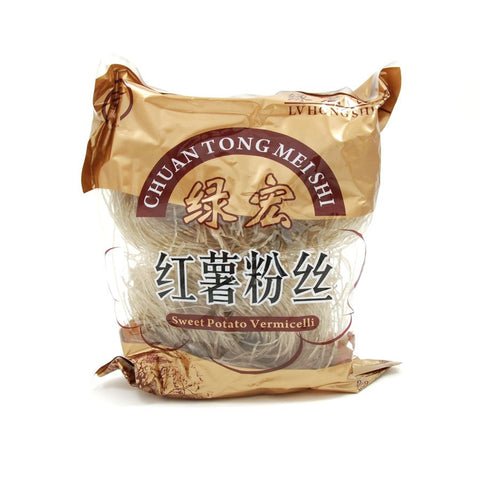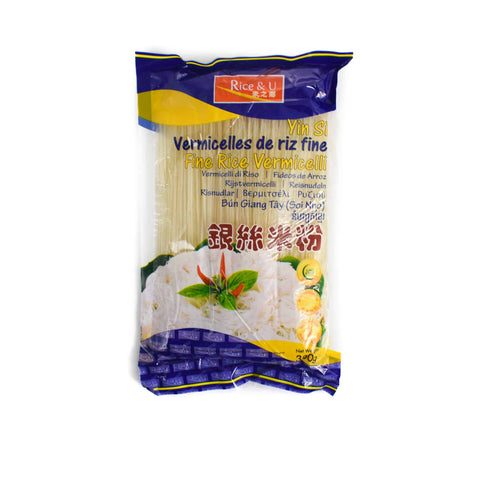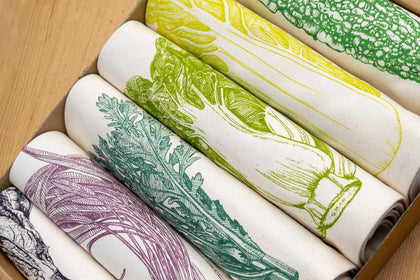Know The Ingredient: What Are Glass Noodles?
by Nicola Lando

The noodle is a widely debated topic.
Where was the first noodle invented? Carbon dating of the world's oldest noodle suggests it was 4,000 years ago in China - not Italy as many Europeans firmly believe.
Can ramen soup contain udon noodles? Absolutely not: ramen is ramen, udon is udon. And what should I buy when when seeking out 'glass noodles'? That's a tougher one, although they certainly won't be labelled rice vermicelli. Here we'll tackle that second question...
Rice noodles are not glass noodles
Traditionally rice noodles or vermicelli were a luxurious treat - if guests came around unexpectedly, instead waiting the hours it takes to properly rinse and steam rice, you could cook a quick dinner in a matter of minutes.
Today they are a staple across Asia.
- In Singapore rice noodles are the base of Singapore fried noodles, with their deep yellow colour from turmeric and curry powder.
- In Vietnam, cold rice noodles stuff summer rolls. And in Thailand, the wider 'tagliatelle' style 'rice sticks' are fried in a pad Thai.
However, rice noodles are white, opaque and certainly not glass-like or translucent - as you'd expect from a glass noodle.
So what are glass noodles?
Glass noodles are made from vegetable starch - most commonly mung bean, and less often sweet potato, or pea.
Semi-translucent when dry, when freshly cooked, glass noodles are truly glass-like and translucent.
We've pulled together a brief guide to help you choose and cook the right vermicelli below. All are great for a gluten free diet, although always double check the packaging.
Mung bean vermicelli are famously used in Thai salads, and 'ants climbing the tree' - a Sichuan Chinese dish, made with minced pork.
When the noodles are lifted up with chopsticks, the pieces of minced pork sticking to the noodles are thought to look like the eponymous ants climbing a tree.
Some favourites from UK food bloggers include serving with scallops, garlic and a little soy often served on the half shell, or the Malaysian and Singaporean Nyonya Chap Chye.
Bean thread vermicelli, also known as mung bean vermicelli, are the most commonly known glass noodles or cellophane noodles.
To cook, simply soak in boiling water for 3 minutes.

Sweet potato vermicelli (or dang myun in Korean) are most famously cooked in the Korean dish Japchae or Chap Chae - fried vegetables with noodles.
The sweet potato was brought to Japan in the 17th Century, and then to Korea in the mid-18th Century to help alleviate famine - and it has been a popular part of the diet in both countries since.
Sweet potato vermicelli are greyish, almost purple in colour. When freshly cooked they are more translucent than in the picture below - they lose their translucence on resting.
The aroma is stronger than bean-thread noodles, although the flavour is little different, especially when stir fried with other ingredients.
To cook, soak in boiling water for 12-15 minutes. They are thicker than bean-thread vermicelli, but are a very good substitute when looking for something a little more substantial.

Rice vermicelli are one type of rice noodle. You can tell the difference with glass noodles as they remain opaque when cooked.
Rice vermicelli - the thin, delicate ones - are perfect for fresh spring rolls and cold salads. They need just a quick soak in hot water, never boiling. Overcook them and they turn to mush.
Wider noodles for Pho or Pad Thai are wider, with more bite. They can handle the heat of a wok or soup and won't fall apart when you're tossing them with sauce and vegetables.
Fresh rice sheets are something else entirely - silky, almost translucent. Roll them around herbs and prawns, or use them for pho. In Vietnam, they'd make these daily.
Shop noodles or browse more Southeast Asian recipes.

About the author
Nicola is co-founder and CEO at Sous Chef. She has worked in food for over ten years.
Nicola first explored cooking as a career when training at Leiths, before spending the next decade in Finance. However... after a stage as a chef at a London Michelin-starred restaurant, Nicola saw the incredible ingredients available only to chefs. And wanted access to them herself. So Sous Chef was born.
Today, Nicola is ingredients buyer and a recipe writer at Sous Chef. She frequently travels internationally to food fairs, and to meet producers. Her cookbook library is vast, and her knowledge of the storecupboard is unrivalled. She tastes thousands of ingredients every year, to select only the best to stock at Sous Chef.
Nicola shares her knowledge of ingredients and writes recipes to showcase those products. Learning from Sous Chef's suppliers and her travels, Nicola writes many of the recipes on the Sous Chef website. Nicola's recipes are big on flavour, where the ingredients truly shine (although that's from someone who cooks for hours each day - so they're rarely tray-bakes!).





